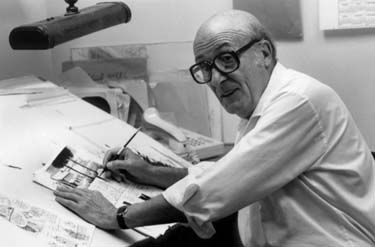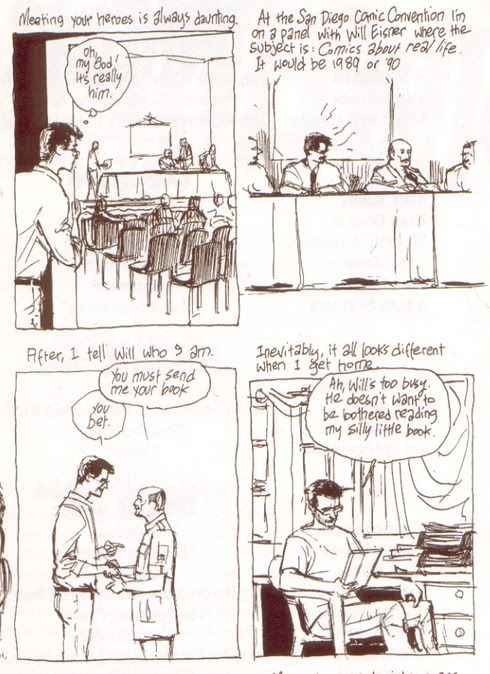
Tgl 19 Sept 2005 yg lalu, dari jurnal Neil Gaiman, ada link ke wawancara dengan Eddie Campbell (yg bersama Alan Moore membuat From Hell). Salah satu hal yang menarik dari wawancara tsb adalah definisi Campbell terhadap istilah graphic novel, yg kesepuluh manifestonya dijabarkan di situs yang sama (saya kopi di bawah ini).
Membaca
point2 pada manifesto itu benar2 mengingatkan pada beberapa posting di
sebuah milis komunitas komik. Salah satunya, seseorang berujar, "Saya
sedang membuat komik nih. Harus berapa halaman ya supaya bisa jadi graphic novel?"
Ah. Apakah benar panjang-pendeknya sebuah kisah bergambar menentukan 'pangkat'nya sebagai graphic novel atau bukan? Bagaimana bila dipaksa2 menjadi panjang, tapi cerita jadi bertele2, hingga membosankan? Lihat A Contract with God-nya Will Eisner,
toh itu kumpulan cerita2 pendek? Atau dipaksa2 dipepet2 seirit mungkin,
hingga banyak penggalan cerita yang hilang? Andaikan seri Sandman-nya Neil Gaiman dipaksakan hanya jadi 5 buku, apakah bisa dinikmati?
Jumlah halaman tidak bisa dijadikan patokan. Menurut point kedua, hal ini dapat mengakibatkan orang berpikir bahwa graphic novel
hanyalah bentuk ilustrasi dari literatur biasa, padahal para pembuatnya
memiliki cita2 lebih, yaitu membentuk karya rupa yg tidak terikat baik
oleh aturan2 yang sudah ada, maupun yang baru.
Graphic novel
mengambil bentuk dasar dari komik (yang dianggap memalukan), dan
mengangkatnya ke tingkat yang lebih berambisi dan bermakna. Hal ini
mengakibatkan berubahnya dimensi fisik si buku, hingga mungkin hasil
akhirnya tidak lagi menyerupai 'buku komik'. Hal ini tidak menjadi
soal. Yang patut dipertanyakan hanyalah, apakah hasil akhirnya
menyumbangkan sesuatu ke pemikiran2 manusiawi.
Hal ini mengingatkan
saya akan kata2 Will Eisner mengenai membuat komik, "Yang penting
adalah, ada sesuatu yang hendak kau sampaikan". 'Sesuatu yg hendak
disampaikan' di sini tidak hanya terbatas sebagai 'pesan moral' seperti
yg kita dapat di akhir dongeng anak2, namun apa pun curahan hati, ide
dan pikiran si pembuat komik. Ya, tanpa itu, komiknya hanya akan
'kosong' saja, tak berisi apa2 selain urutan gambar2 dan adegan2 aksi.

Will Eisner di meja kerjanya
Salah satu point Campbell juga menyatakan bahwa para pembuat graphic novel tidak akan menyebut karya mereka sendiri sebagai "graphic novel"
di antara rekan2nya. Istilah tersebut hanyalah dipakai utk, misalkan,
mendefinisikan penempatan buku2 tsb pada rak di toko-toko buku yang
belum akrab dengan bentuk/isi buku tsb. Membaca bagian ini, sempat
membuat saya tersenyum sendiri, terutama pada kalimat penutupnya: "Furthermore,
graphic novelists are well aware that the next wave of cartoonists will
choose to work in the smallest possible forms and will ridicule us all
for our pomposity".
Benar, bahwa kita mestinya harus kritis terhadap karya sendiri dan tidak cepat puas dengan menyebutnya "graphic novel"
dengan berbangga hati. Biarlah para pembaca yang menilai, mengapresiasi
dan menentukan hal tersebut. Memberi label pada karya sendiri sering
berakibat pembatasan diri, atau penentuan (tingginya) standar yang
bisa2 menghalang proses berkreasi. Sekali lagi, menurut saya, berkarya
dan berkaryalah terus - bahwa karya2 tsb diterima sebagai bentuk seni
berkualitas atau bukan, akan dibuktikan oleh apresiasi masyarakat.
Sebagai penutup entry kali ini, saya kutipkan salah satu kutipan dari wawancara tsb, mengenai konsep "komik":
"I
have felt that the concept of what comics is gets narrower as we go
along. Each writer on the subject who defines comics wants to exclude
something. McCloud excludes the single panel so Family Circus and Far Side are out. Blackbeard says there must be word balloons so Prince Valiant
is out. Harvey says there has to be a visual-verbal balance. Somebody
else says there must be no redundancy of information with words and
pictures repeating each other. This is crap. Pictures have illustrated
words and words have explained pictures since the beginning of time.
Somebody reads a dull comic and extrapolates rules from it. Who do they
think they are? There are all these people trying to be the rule-makers
and the end result is bad for the art of Comics. Fuck 'em all, that's
what I say."

Karya Campbell dalam buku BioGraphics
Berikut ini adalah kopian dari manifesto Campbell, dan link menuju ke situs wawancara selengkapnya: excerpt from In Depth: the Eddie Campbell Interview by Milo George from Graphic Novel Review Issue 1
Eddie Campbell's (Revised) Graphic Novel Manifesto
There
is so much disagreement (among ourselves) and misunderstanding (on the
part of the public) around the subject of the graphic novel that it's
high time a set of principles were laid down.
1. "Graphic novel" is a disagreeable term, but we will use it anyway on the understanding that graphic does not mean anything to do with graphics and that novel
does not mean anything to do with novels. (In the same way that
"Impressionism" is not really an applicable term; in fact it was first
used as an insult and then adopted in a spirit of defiance.)
2.
Since we are not in any way referring to the traditional literary
novel, we do not hold that the graphic novel should be of the supposed
same dimensions or physical weight. Thus subsidiary terms such as
"novella" and "novelette" are of no use here and will only serve to
confuse onlookers as to our goal (see below), causing them to think we
are creating an illustrated version of standard literature when in fact
we have bigger fish to fry; that is, we are forging a whole new art
which will not be bound by the arbitrary rules of an old one.
3.
"Graphic novel" signifies a movement rather than a form. Thus we may
refer to "antecedents" of the graphic novel, such as Lynd Ward's
woodcut novels but we are not interested in applying the name
retroactively.
4. While the graphic novelist regards his various
antecedents as geniuses and prophets without whose work he could not
have envisioned his own, he does not want to be obliged to stand in
line behind William Hogarth's Rake's Progress every time he obtains a piece of publicity for himself or the art in general.
5.
Since the term signifies a movement, or an ongoing event, rather than a
form, there is nothing to be gained by defining it or "measuring" it.
It is approximately thirty years old, though the concept and name had
been bandied about for at least ten years earlier. As it is still
growing it will in all probability have changed its nature by this time
next year.
6. The goal of the graphic novelist is to take the
form of the comic book, which has become an embarrassment, and raise it
to a more ambitious and meaningful level. This normally involves
expanding its size, but we should avoid getting into arguments about
permissible size. If an artist offers a set of short stories as his new
graphic novel, (as Eisner did with A Contract with God)
we should not descend to quibbling. We should only ask whether his new
graphic novel is a good or bad set of short stories. If he or she uses
characters that appear in another place, such as Jimmy Corrigan's
various appearances outside of the core book, or Gilbert Hernandez'
etc. or even characters that we do not want to allow into our "secret
society," we shall not dismiss them on this account. If his book no
longer looks anything like comic books we should not quibble as to that
either. We should only ask whether it increases the sum total of human
wisdom.
7. The term graphic novel shall not be taken to indicate
a trade format (such as "trade paperback" or "hardcover" or "prestige
format"). It can be in unpublished manuscript form, or serialized in
parts. The important thing is the intent, even if the intent arrives
after the original publication.
8. The graphic novelists'
subject is all of existence, including their own life. He or she
disdains "genre fiction" and all its ugly clichés, though they try to
keep an open mind. They are particularly resentful of the notion, still
prevalent in many places, and not without reason, that the comic book
is a sub-genre of science fiction or heroic fantasy.
9. Graphic
novelists would never think of using the term graphic novel when
speaking among their fellows. They would normally just refer to their
"latest book" or their "work in progress" or "that old potboiler" or
even "comic" etc. The term is to be used as an emblem or an old flag
that is brought out for the call to battle or when mumbling an enquiry
as to the location of a certain section in an unfamiliar bookstore.
Publishers may use the term over and over until it means even less than
the nothing it means already.
Furthermore, graphic novelists
are well aware that the next wave of cartoonists will choose to work in
the smallest possible forms and will ridicule us all for our pomposity.
10. The graphic novelist reserves the right to deny any or all of the above if it means a quick sale.
Illustration: Detail from The Fate of The Artist (C)2004 Eddie Campbell
Tita, 19 Sept 2005

No comments:
Post a Comment